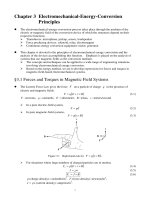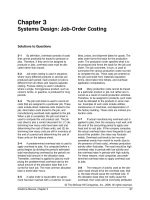Kendall7E ch03
Bạn đang xem bản rút gọn của tài liệu. Xem và tải ngay bản đầy đủ của tài liệu tại đây (1.16 MB, 50 trang )
Project
Management
Systems Analysis and Design,
7e
Kendall & Kendall
©2008 Pearson Prentice Hall
3
Learning Objectives
• Understand how projects are initiated and
selected
• Define a business problem and determine the
feasibility of a proposed project
• Plan a project by identifying activities and
scheduling them
• Understand how an alternative approach called
agile development balances objectives to manage
the analysis and design process
• Manage team members and analysis and design
activities so the project objectives are met while
the project remains on schedule
Kendall & Kendall
3-2
Project Management
Fundamentals
• Project initiation
• Determining project feasibility
• Activity planning and control
• Project scheduling
• Managing systems analysis team
members
Kendall & Kendall
3-3
Major Topics
•
•
•
•
Project Initiation
Determining feasibility
Determining resources
Activity planning and control
• Gantt charts
• PERT diagrams
• Managing analysis and design activities
• The Agile approach
Kendall & Kendall
3-4
Project Initiation
• Problems in the organization
• Problems that lend themselves to
systems solutions
• Opportunities for improvement
• Caused through upgrading, altering,
or installing new systems
Kendall & Kendall
3-5
Figure 3.1 Checking output, observing employee
behavior, and listening to feedback are all ways
to help the analyst pinpoint systems problems
and opportunities
Kendall & Kendall
3-6
Problem Definition
• Problem statement
• Paragraph or two stating the problem or opportunity
• Issues
• Independent pieces pertaining to the problem or
opportunity
• Objectives
• Goals that match the issues point-by-point
• Requirements
• The things that must be accomplished along with the
possible solutions, and constraints, that limit the
development of the system
Kendall & Kendall
3-7
Problem Definition Steps
• Find a number of points that may
be included in one issue
• State the objective
• Determine the relative importance
of the issues or objectives
• Identify which objectives are most
critical
Kendall & Kendall
3-8
Selection Of Projects
• Backing from management
• Appropriate timing of project commitment
• Possibility of improving attainment of
organizational goals
• Practical in terms of resources for the
system analyst and organization
• Worthwhile project compared with other
ways the organization could invest
resources
Kendall & Kendall
3-9
Determining Feasibility
• Defining objectives
• Determining resources
• Operationally
• Technically
• Economically
Kendall & Kendall
3-10
Defining Objectives
Many possible objectives exist including:
•
•
•
•
•
•
•
Speeding up a process
Streamlining a process
Combining processes
Reducing errors in input
Reducing redundant storage
Reducing redundant output
Improving system and subsystem integration
Kendall & Kendall
3-11
Feasibility Impact Grid
(FIG)
• A feasibility impact grid (FIG) is
used to assess the impact of any
improvements to the existing
system
• It can increase awareness of the
impacts made on the achievement
of corporate objectives
Kendall & Kendall
3-12
Figure 3.3 An analyst can use a feasibility impact
grid to show how each system component affects
process objectives
Kendall & Kendall
3-13
Figure 3.4 An analyst can use a feasibility impact grid
to show how each system component affects corporate
objectives
Kendall & Kendall
3-14
Figure 3.5 The three key elements of
feasibility include technical, economic, and
operational feasibility
Kendall & Kendall
3-15
Technical Feasibility
• Can current technical resources be
upgraded or added to in a manner
that fulfills the request under
consideration
• If not, is there technology in
existence that meets the
specifications
Kendall & Kendall
3-16
Economic Feasibility
• Economic feasibility determines
whether value of the investment
exceeds the time and cost
• Includes:
•
•
•
•
•
Analyst and analyst team time
Business employee time
Hardware
Software
Software development
Kendall & Kendall
3-17
Operational Feasibility
• Operational feasibility determines
if the human resources are
available to operate the system
once it has been installed
• Users that do not want a new
system may prevent it from
becoming operationally feasible
Kendall & Kendall
3-18
Activity Planning And
Control
• Planning includes:
• Selecting a systems analysis team
• Estimating time required to complete each task
• Scheduling the project
• Control includes:
• Comparing the plan for the project with its
actual evolution
• Taking appropriate action to expedite or
reschedule activities
Kendall & Kendall
3-19
Estimating Time
• Project is broken down into phases
• Further project is broken down into tasks
or activities
• Finally project is broken down into steps
or even smaller units
• Time is estimated for each task or activity
• Most likely, pessimistic, and optimistic
estimates for time may be used
Kendall & Kendall
3-20









